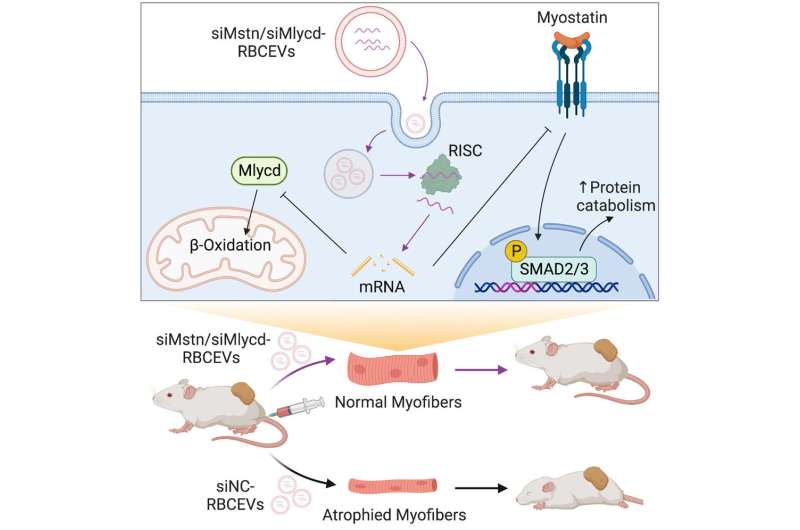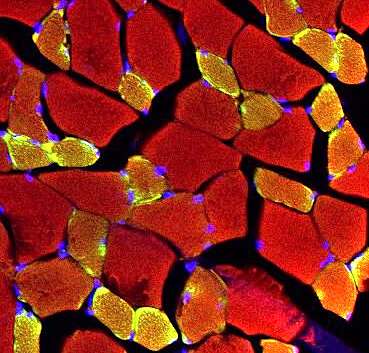Study finds red blood cell particles are effective drug carriers in suppressing muscle loss caused by cancer

Cancer is a complex systemic disease, with accompanying secondary effects that can result in debilitating effects on the human body. Cancer-associated skeletal muscle weakening or loss, also called “cancer cachexia,” is a prevalent and serious condition responsible for 20%–30% of the deaths in affected cancer patients. In current treatments for cancer cachexia, there are limitations in efficacy levels and significant side effects.
A new study led by researchers at the Institute for Digital Medicine (WisDM) and the Department of Pharmacology, Yong Loo Lin School of Medicine, National University of Singapore (NUS Medicine), in collaboration with the Chinese Academy of Sciences (CAS), and City University of Hong Kong (CityU), examined a new gene therapy strategy for reversing cancer cachexia. The team used nano-sized particles released by red blood cells, termed “red blood cell-derived extracellular vesicles” (RBCEVs), to package and transport RNA-based drug molecules to muscle cells in the body.
Published in Molecular Therapy, the study found that drug-loaded RBCEVs inhibited target genes could increase muscle growth and suppress cancer cachexia. Compared to the delivery of a single RNA drug, muscle growth was observed to be further enhanced when two RNA drugs targeting two different genes implicated in cancer cachexia were loaded into the same RBCEVs. Importantly, repeated administrations with RBCEVs did not induce toxicity or inflammatory reactions, which is a prerequisite for clinical trials on humans.
“There is a lot of potential in using RNA-based drugs for conditions that are difficult to treat, but the delivery has always been tricky. From our previous and current studies, we have found that the RBCEV delivery platform can help to overcome some of the long-standing technical challenges in the field,” said Assistant Professor Minh Le from WisDM and the Department of Pharmacology at NUS Medicine, who led the study.

Professor Ng Shyh-Chang, Principal Investigator for the State Key Laboratory of Stem Cell and Reproductive Biology at the CAS Institute of Zoology, who co-directed the study, added, “Building on previous target discovery work, this is one of the first studies to leverage RNA therapies to treat cancer cachexia. This could lead to the use EV-based gene therapies to address unmet needs in cachexia and sarcopenia.”
The team has plans for further collaborations to test the use of RBCEV-delivered therapeutics against other targets in the muscles. At the same time, they have been working on applying RBCEVs to the treatment of different cancers, cardiovascular diseases, and COVID-19. Accumulating data from their studies, the RBCEV has shown to be a robust, safe and versatile platform.
As the collective understanding of RBCEV biology and related technologies continue to mature, the RBCEV platform is well-positioned for clinical translation to provide safer and more efficacious treatment options for muscle degenerative conditions as well as other challenging diseases.
More information:
Boya Peng et al, Red blood cell extracellular vesicles deliver therapeutic siRNAs to skeletal muscles for treatment of cancer cachexia, Molecular Therapy (2023). DOI: 10.1016/j.ymthe.2023.03.036
Citation:
Study finds red blood cell particles are effective drug carriers in suppressing muscle loss caused by cancer (2023, April 24)
retrieved 24 April 2023
from https://phys.org/news/2023-04-red-blood-cell-particles-effective.html
This document is subject to copyright. Apart from any fair dealing for the purpose of private study or research, no
part may be reproduced without the written permission. The content is provided for information purposes only.
For all the latest Science News Click Here
For the latest news and updates, follow us on Google News.

